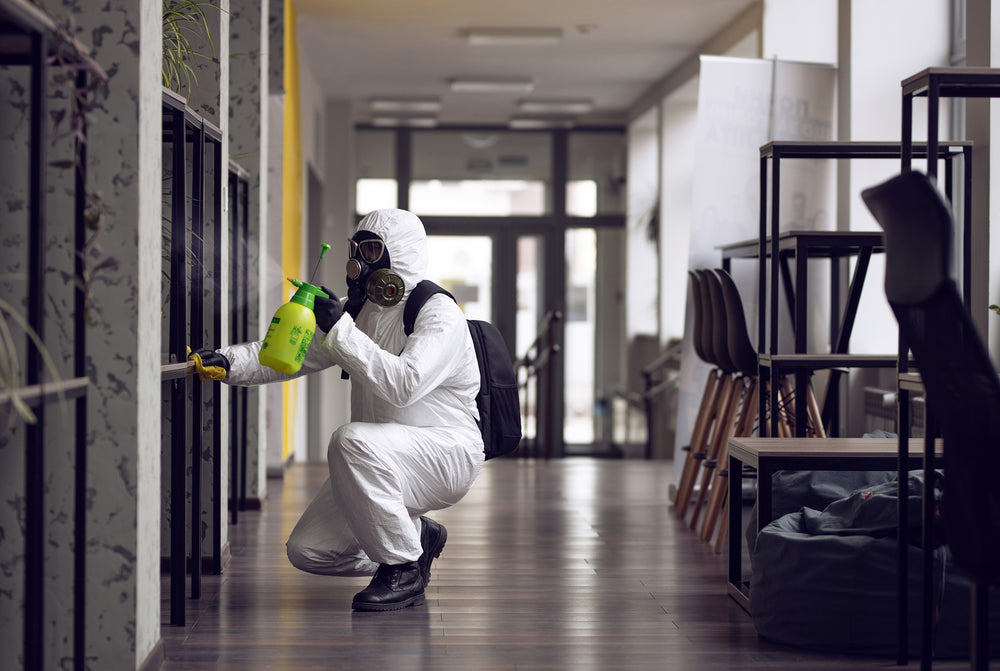You've just settled into your desk, coffee in hand, ready to tackle the day's tasks. But as you inhale deeply, you catch a whiff of something musty and damp lingering in the air. It's an all-too-familiar smell that sets off alarm bells in your mind – mold.
The presence of mold in office spaces is unpleasant and can pose serious health risks to employees. Mold thrives in damp, humid environments and can quickly spread, releasing spores that can trigger allergic reactions, respiratory issues, and other health problems. With employees spending a significant portion of their day in the office, addressing mold growth should be a top priority for employers.
Fortunately, there are effective strategies for managing mold in office buildings, ensuring a healthier and more productive work environment for all. Let's discuss common mold issues, identification methods, preventive measures, and combat strategies to keep your office space mold-free and employee-friendly.
Common Office Mold Issues
Mold is a type of fungus that grows from tiny spores, thriving in warm, damp environments with poor ventilation. While mold exists naturally outdoors, it can easily find its way indoors through open windows, vents, or even on clothing and settle in areas with excess moisture.
Some of the most common types of mold found in office buildings include Aspergillus, Cladosporium, and Stachybotrys (commonly known as black mold). These molds can grow on various surfaces such as walls, carpets, insulation, and even furniture, feeding on organic materials like wood, paper, or fabric.
Exposure to mold spores can cause a range of health effects for employees, including respiratory issues like coughing, wheezing, and asthma attacks. It can also lead to allergic reactions, skin irritation, and even immune system suppression in severe cases.
Identifying Mold in Your Office
Identifying the presence of mold in your office space is the first step toward effective management. Some telltale signs to watch out for include:
- Musty or earthy odors
- Visible growth or discoloration on surfaces
- Water stains or moisture buildup
- Employee complaints of headaches, respiratory issues, or allergy-like symptoms
If you suspect mold growth in your office, hiring a professional mold inspection service is crucial. These experts have the necessary equipment and knowledge to detect and assess the extent of the mold infestation, even in hidden areas. Early detection is key to preventing further spread and minimizing potential health risks for employees.
Preventive Measures for Mold
While mold can be a persistent problem, there are several preventive measures you can take to keep it at bay:
- Keeping the office clean and well-ventilated: Regular cleaning routines, especially in high-moisture areas like bathrooms and kitchens, can help remove mold spores and prevent growth. Ensuring proper ventilation by maintaining HVAC systems and opening windows can also promote airflow and reduce humidity levels.
- Managing humidity levels: Mold thrives in humid environments, so it's essential to maintain indoor humidity levels below 50%. Consider investing in dehumidifiers, especially in areas prone to moisture buildup, and addressing any leaks or water damage promptly.
- Encouraging good habits: Educating employees on mold prevention and proper hygiene practices can go a long way. Promote habits like wiping down surfaces after spills, using exhaust fans in bathrooms and kitchens, and promptly reporting any signs of moisture or mold growth.
Combatting Mold: Effective Strategies
Even with preventive measures in place, mold infestations can still occur. In such cases, a multi-pronged approach is necessary:
- Utilizing air purifiers: Air Oasis air purifiers are designed to eliminate mold spores and other airborne contaminants from indoor spaces. They incorporate an advanced technology combination, including Bi-polar ionization, activated carbon, True H13 HEPA filtration, silver ions, and UV-C light, to effectively neutralize mold spores, reduce the risk of exposure, and prevent further growth.
- Investing in moisture control solutions: Addressing the underlying moisture issues that contribute to mold growth is critical. This may involve repairing leaks, improving drainage systems, or investing in waterproofing solutions. Professional moisture control services can help identify and resolve these issues effectively.
- Regular maintenance checks: Implementing a routine maintenance schedule for your office spaces can help catch mold infestations early. Qualified professionals can inspect your office spaces regularly to identify potential problem areas and address them before they escalate.
Creating a Healthy Office Environment for All
Maintaining a mold-free workspace offers numerous benefits for employee health and productivity. By reducing exposure to mold spores and improving indoor air quality, employees are less likely to experience allergic reactions, respiratory issues, or other health problems associated with mold. This, in turn, can lead to fewer sick days, increased focus, and enhanced overall well-being.
Moreover, fostering a workplace culture of cleanliness and awareness can empower employees to take an active role in mold prevention. Employers can create a collaborative environment where everyone contributes to a healthier workspace by encouraging good habits and promoting open communication about potential mold issues.
Employers have a responsibility to ensure a safe and healthy work environment for their employees. Investing in effective mold management strategies, such as Air Oasis air purifiers, not only demonstrates a commitment to employee well-being but can also positively impact productivity and morale.
Remember, clean air is essential for employee health and comfort. By taking proactive steps to prevent and address mold infestations, you can create a workspace that promotes productivity, reduces absenteeism, and fosters a positive work culture.
If you're ready to prioritize your employees' health and well-being, consider investing in Air Oasis air purifiers for your office spaces – our new Pro-sized iAdaptAir is perfect for large spaces. Shop Air Oasis and explore our range of science-backed air purification solutions for managing mold and improving indoor air quality.



